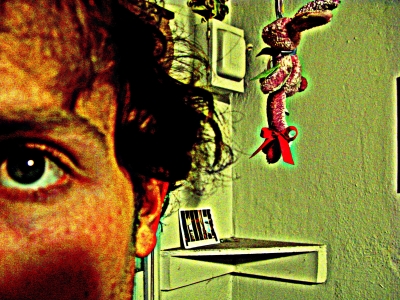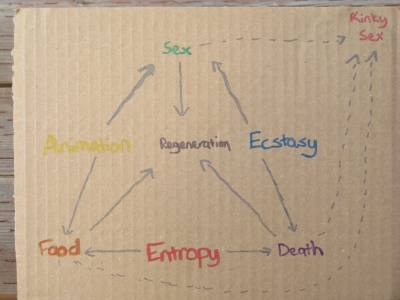

15 + 5 points
Graph of Desire by Warren Vengeance
January 13th, 2008 3:56 PM
THE WHEEL OF DESIRE

Okay, so a more technical explanation follows in green, but here I'll try to keep it as simple as I can. Animation, Ecstasy, and Entropy are our most basic, deepest desires. When two of the three intermingle and congeal they take a more rigid form and become more familiar, everyday life-type desires. So there are three of these (because in a set of three, there are three combinations of two): Food, Death, and Sex. We know and love these desires, don't we? (Death is a deep-seated desire; Freud called it the Thanatos instinct, after the Greek word for death).
Now when these three desires -- food death, and sex -- all mush together into one, you get regeneration. So the need for regeneration is actually the necessary result of, ultimately, my combined needs for Animation, Ecstasy, and Entropy. But Regeneration, because it unifies all our most basic desires, becomes the driving force behind our actions. It is our unified presence of being: why we fuck, why we love, why we make friends and bury our pets, why we play and think and dance and snuggle. It constantly mystifies us, and makes life vibrant and unexpected. Regeneration includes and subsumes life, death and food (food being the process by which dead things become living). It proves that they are all part of the cycle, an endless wheel.
I've been told I need to clarify my puns. I call this the Wheel of Desire because it makes reference to the Buddhist wheel of life, the samsara. The samsara is the cycle by which humans are born, die, and are reborn. My graph is also a wheel because it is modeled off of the color wheel -- the combination of needs works in the same way as the combination of pigments.
---
This is the green section. The Sentence structure is convoluted and may be hard to follow, but here I offer the full explanation. Please consider the following text a critique, a review, of this piece of psychology, rather than its completion. Please feel free not to read this part if you wish to keep it simple.
The other-minds problem prevents me from concluding that this graph explains the purpose of being for all persons, real or virtual. Nonetheless, I suspect this to be the case. In any event, I modeled it on my own brain.
First-order (most basic) desires are three:
Animation: life giving truth, inhalation, movement, pumping blood, body. Animation directly drives my psychological need for exercise and excitement. Animation is my need to inhabit my body and be physically and mentally present.
Ecstasy: literally meaning the state of being outside oneself, Ecstasy is that which gives birth to the spiritual, to unconventional thought, to inquisitiveness, to exploration, to psychedelic drugs.
Entropy: the need to experience time and decay. Entropy also drives growth -- note that the difference between mathematical formulae for growth and decay is but a positive exponent rather than a negative. The need for Entropy grows in complexity as I mature, and I learn to appreciate ever-expanding cycles of growth subsumed by decay, and decay subsumed by growth.
Notably, meditation may focus on any of these first-order needs.
Second-order needs, as implied by the graph, come from the wholeness-making interconnection of first-order needs. It should be clear, based on the preceding clarification, why the first-order needs intersect as they do. Some second-order needs are representative of a somewhat larger intersection; "Sex", for example, would also include empathy. For the most part, however, second-order needs are more concrete and easier to fully grasp than their first-order counterparts.
Third-order needs exist in abundance, and proliferate and expand as we exist and mature. Thrill-seeking, I contend, would be a third-order need, an ironic intersection of Animation and Death -- note that they lie opposite each other on the wheel. For clarity, the billions of possible third-order needs have been left off this graph.
But for two. These third-order needs are holistic, in the sense that they form of the combined full expression of all three second-order needs.
The second-order needs elucidate in their full interaction what for the first-order would for most people be opaque, but either triad would result in the same output, the unified purpose of being: regeneration. While they have failed to comprehend its origins, biologists have explored for over a century the notion that regeneration is the primary motive for our actions. The love and truth I find in regeneration, as well as its full embodiment and representation of primary and secondary needs, recommends its centrality on the wheel. In practice, it becomes an axle about which our desires revolve.
Some may argue that kinky sex is similarly central to his or her being. Others would call it a perversion of our higher-order needs. On this I make no judgment, but believe that the logical separation of expression and perversion is tenuous at best. That notwithstanding, I placed kinky sex on the outskirts of being because -- for myself -- it is not so rudimentary to my existence as regeneration. For you it may be different, and I would not object to an alternative placement of this need.

Okay, so a more technical explanation follows in green, but here I'll try to keep it as simple as I can. Animation, Ecstasy, and Entropy are our most basic, deepest desires. When two of the three intermingle and congeal they take a more rigid form and become more familiar, everyday life-type desires. So there are three of these (because in a set of three, there are three combinations of two): Food, Death, and Sex. We know and love these desires, don't we? (Death is a deep-seated desire; Freud called it the Thanatos instinct, after the Greek word for death).
Now when these three desires -- food death, and sex -- all mush together into one, you get regeneration. So the need for regeneration is actually the necessary result of, ultimately, my combined needs for Animation, Ecstasy, and Entropy. But Regeneration, because it unifies all our most basic desires, becomes the driving force behind our actions. It is our unified presence of being: why we fuck, why we love, why we make friends and bury our pets, why we play and think and dance and snuggle. It constantly mystifies us, and makes life vibrant and unexpected. Regeneration includes and subsumes life, death and food (food being the process by which dead things become living). It proves that they are all part of the cycle, an endless wheel.
I've been told I need to clarify my puns. I call this the Wheel of Desire because it makes reference to the Buddhist wheel of life, the samsara. The samsara is the cycle by which humans are born, die, and are reborn. My graph is also a wheel because it is modeled off of the color wheel -- the combination of needs works in the same way as the combination of pigments.
---
This is the green section. The Sentence structure is convoluted and may be hard to follow, but here I offer the full explanation. Please consider the following text a critique, a review, of this piece of psychology, rather than its completion. Please feel free not to read this part if you wish to keep it simple.
The other-minds problem prevents me from concluding that this graph explains the purpose of being for all persons, real or virtual. Nonetheless, I suspect this to be the case. In any event, I modeled it on my own brain.
First-order (most basic) desires are three:
Animation: life giving truth, inhalation, movement, pumping blood, body. Animation directly drives my psychological need for exercise and excitement. Animation is my need to inhabit my body and be physically and mentally present.
Ecstasy: literally meaning the state of being outside oneself, Ecstasy is that which gives birth to the spiritual, to unconventional thought, to inquisitiveness, to exploration, to psychedelic drugs.
Entropy: the need to experience time and decay. Entropy also drives growth -- note that the difference between mathematical formulae for growth and decay is but a positive exponent rather than a negative. The need for Entropy grows in complexity as I mature, and I learn to appreciate ever-expanding cycles of growth subsumed by decay, and decay subsumed by growth.
Notably, meditation may focus on any of these first-order needs.
Second-order needs, as implied by the graph, come from the wholeness-making interconnection of first-order needs. It should be clear, based on the preceding clarification, why the first-order needs intersect as they do. Some second-order needs are representative of a somewhat larger intersection; "Sex", for example, would also include empathy. For the most part, however, second-order needs are more concrete and easier to fully grasp than their first-order counterparts.
Third-order needs exist in abundance, and proliferate and expand as we exist and mature. Thrill-seeking, I contend, would be a third-order need, an ironic intersection of Animation and Death -- note that they lie opposite each other on the wheel. For clarity, the billions of possible third-order needs have been left off this graph.
But for two. These third-order needs are holistic, in the sense that they form of the combined full expression of all three second-order needs.
The second-order needs elucidate in their full interaction what for the first-order would for most people be opaque, but either triad would result in the same output, the unified purpose of being: regeneration. While they have failed to comprehend its origins, biologists have explored for over a century the notion that regeneration is the primary motive for our actions. The love and truth I find in regeneration, as well as its full embodiment and representation of primary and secondary needs, recommends its centrality on the wheel. In practice, it becomes an axle about which our desires revolve.
Some may argue that kinky sex is similarly central to his or her being. Others would call it a perversion of our higher-order needs. On this I make no judgment, but believe that the logical separation of expression and perversion is tenuous at best. That notwithstanding, I placed kinky sex on the outskirts of being because -- for myself -- it is not so rudimentary to my existence as regeneration. For you it may be different, and I would not object to an alternative placement of this need.
1 vote(s)
Terms
(none yet)2 comment(s)
posted by Warren Vengeance on January 14th, 2008 6:38 PM
Because I can use text!
The other-minds problem is more basic than qualia. Luckily it's also on wikipedia. It says this: I know I have a mind, right? I think, therefore I am, and all that junk. But how do I know that you have a mind? How do I know that you are a conscious being that thinks and feels, and isn't moving around merely on bioelectricity and instinct? I can't know for sure. I can't prove logically that you have a mind, and I certainly can't prove that I can describe your mind if indeed you have one.














"Or skip it."?! I rather not.
"The other minds problem"? Do you mean qualia?
I am not sure that I get the graph fully (what do the arrows mean? cause?) but it is certainly intriguing.